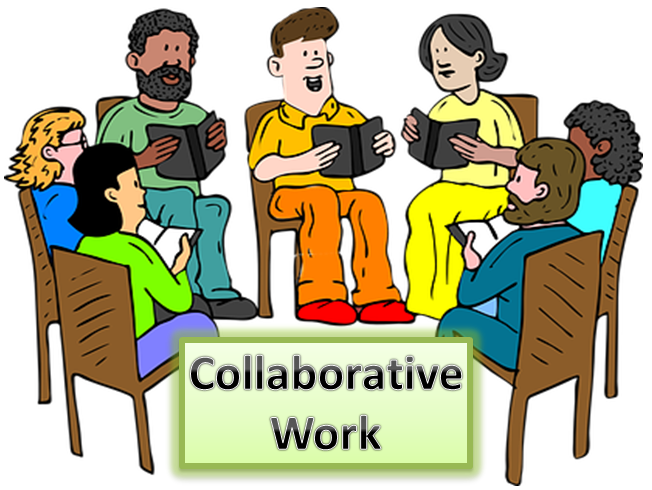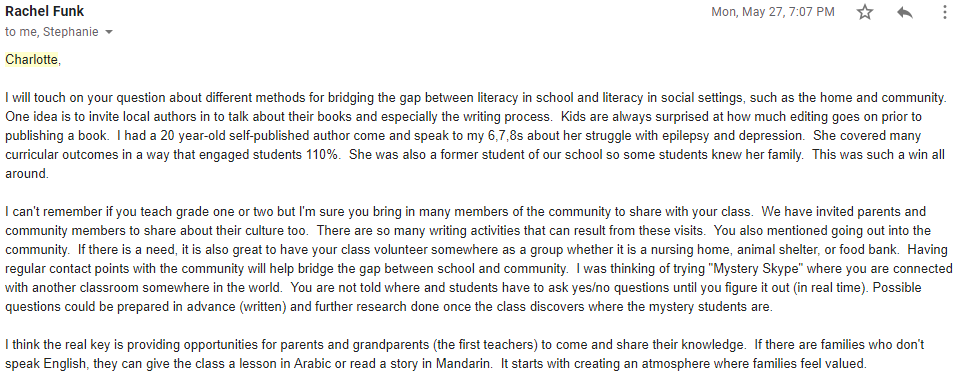The Writerly and Social Readers
Students do not attend school as blank slates. Prior to their first day, many of them have already been exposed to various forms of reading and writing. This usually occurs within a social context where children are either read to or read to their parents and some even practice writing skills such as working on their alphabets to be able to articulate their learning.
Overtime, as students develop their reading and writing abilities, starting from the primary grades, they learn how to critically assess and engage with their reading by learning how to do research and assessing their background knowledge to make connections. Students are first taught about different pre, during and post reading skills so that they are “able to plan, organize, collaborate, and engage in collective action” (Tierney, 2019, p. 1). These are essential lessons so that students learn how to comprehend multilayered texts over time. I then take time to teach students about revising their work at least twice before handing it in. In this way, students learn how to critically analyze their own writing before learning how to assess various books.
In my class, I use Adrienne Gear’s Reading Power and Writing Power to teach skills such as connecting, visualizing, questioning, inferring and transforming so that students can make informed evaluations about their reading. To ensure that they understand these concepts, we spend about a week to even a month on each concept. Each week we read books from different genres in relation to each skill. As a class, we work on pre-reading skills, like making predictions about the book as a class. Students then work on during-reading activities individually by either answering questions, making notes or drawing as we read. Finally, they participate in post-reading activities where they engage in collaborative discussion in small groups and add to their notes. After students have had time with their groups, we have a class discussion to ensure multiple streams of learning. After, we learn how to work in groups. Each student receives a job, such as a writer, reader, artist, predictor and leader. All of these roles are also outlined in Tierney’s video (2019) and in Tierney and Pearson’s article, Toward a Composing Model of Reading, “planning,” “drafting,” “aligning,” “revising,” and “monitoring” (1983, p. 578). Students learn how to ask questions, voice their learning, listen to each other, summarize and illustrate their group’s thoughts. I find that working in small groups provides students with a platform to share their ideas. This is especially effective for those who are either shy, have anxiety when speaking in front of the class and whose first language in not English. Collaborative work enables students to “engage in, navigate, and generate communications that involve transmediation across multimodal and multilayered […] platforms” (Tierney, 2019, p. 2).
After, we learn how to work in groups. Each student receives a job, such as a writer, reader, artist, predictor and leader. All of these roles are also outlined in Tierney’s video (2019) and in Tierney and Pearson’s article, Toward a Composing Model of Reading, “planning,” “drafting,” “aligning,” “revising,” and “monitoring” (1983, p. 578). Students learn how to ask questions, voice their learning, listen to each other, summarize and illustrate their group’s thoughts. I find that working in small groups provides students with a platform to share their ideas. This is especially effective for those who are either shy, have anxiety when speaking in front of the class and whose first language in not English. Collaborative work enables students to “engage in, navigate, and generate communications that involve transmediation across multimodal and multilayered […] platforms” (Tierney, 2019, p. 2).
While much research has been conducted in regards to combining reading and writing skills for both younger and older children, the social aspect has not been well documented. Currently not just older, but younger students as well are now engaging in social forms of reading via the internet, through video games, and by contacting each other and their family members through text messaging. Students are learning how to read intonations and communicate their thoughts in a variety of ways, such as through a variety of mediums.
Historically, reading and writing strategies have been taught separately, whereas currently they are being taught in conjunction with each other. This combination makes more sense as not only are the strategies fairly similar but in real life, both of these activities are done in combination with each other. However, according to Tierney’s video (2019), when we teach these skills in a classroom setting, there are so many restrictions where students are not able to fully enjoy the reading process. Nevertheless, when children read for social purposes they are able to fully embrace in the development of these skills. I am curious about different methods that can be employed to bridge the gap between literacy in an educational and social setting. Would it be more conducive to take students outside of the classroom to involve them in discussion or are there specific games that we can play to aid in this process? Are there any resources available that can explain these concepts in more detail? I believe that these teaching these strategies are important, but if it is overemphasized, it may promote disengagement. Therefore, how do we find a balance and how can we create individualized and differentiated lessons for our students?
Reference Beyond The Required Readings
Tierney, R. J. & Pearson, P. D. (1983). Toward a composing model of reading. Language Arts, 60,
5, May, 568-580.
https://www.academia.edu/9764944/Tierney_R._J._and_Pearson_P._D._1983_._Toward
_a_composing_model_of_reading._Language_Arts_60_5_May_568-580
Responses


